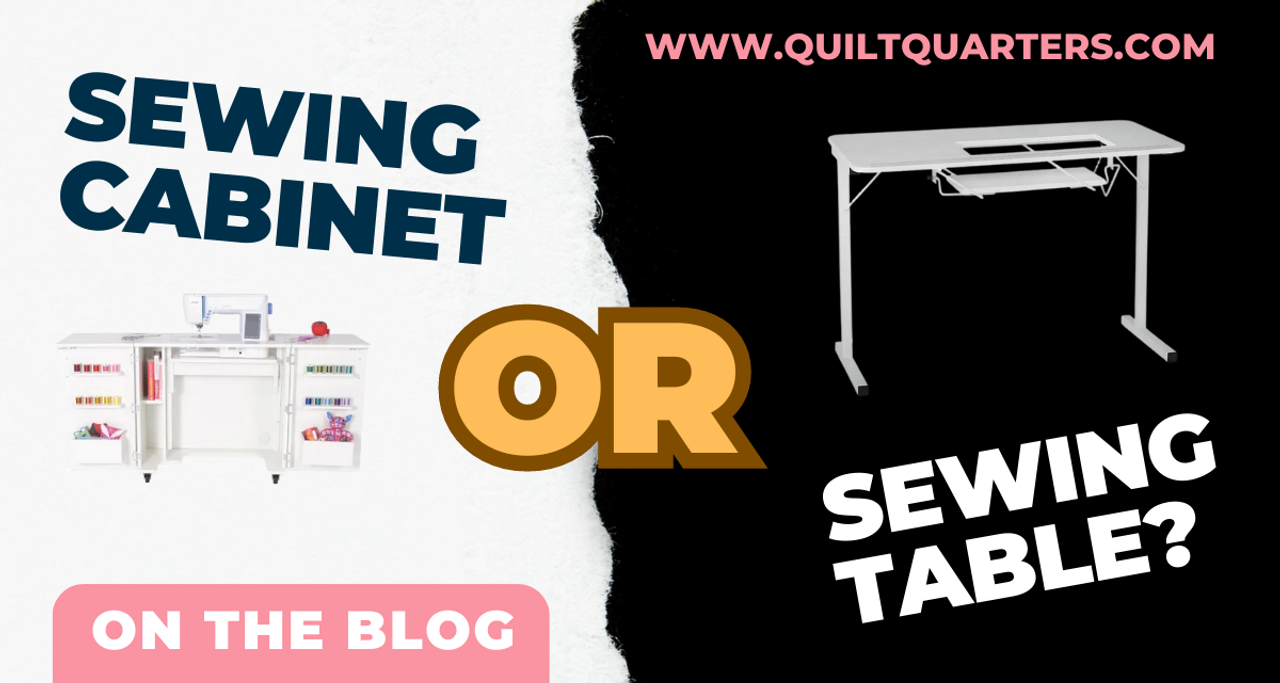So, you've decided to make the jump and clear off that space on your dining table or countertop that's constantly filled up with sewing notions, your machine, and various bits and bobbins. One sewing project turns into another, then another, and soon enough, your machine seems to permanently be out on the surfaces that you need in everyday life.
But where do you put it? There never seems to be a place dedicated to your sewing machine, so you take a look at Quilt Quarter's website and find our "Sewing Tables" and "Sewing Cabinets" tabs to take a look. There are plenty of different kinds, shapes, and sizes, but we guarantee that there is one meant for you.
Here's a few considerations to keep in mind as you decide to make a big purchase for your sewing space.
1. Portability
One of the primary difference between sewing tables and sewing cabinets is the power of portability. If you think you'll be taking your sewing on the road, such as to sewing guilds, on RVs, to your vacation spot, or between rooms in your home, then you'll want to start looking at the lightweight sewing tables. They might not have as much storage as cabinets, but they give you a sturdy, reliable space dedicated to sewing with the option of adding storage.
2. Storage
Do you have a lot of notions, loose fabric, or other items like irons, other machines, or hoops? Then you might want more storage! Sewing cabinets will give you the most storage between that and tables, but not all sewing cabinets contain the same amount of storage. Some will have more drawers in different styles, some will more compact, some will include storage pegs or shelves, and others won't - which one you'll want in your sewing space is all up to how many supplies you have to store!
3. Machine Position
Some tables and cabinets will have different machine positioning options, including:
- Flat-bed
- Free-arm
- Storage
- Flush with the table (Usually only available with a custom acrylic insert)
Depending on if you need all 3 or 4 positions, sewing cabinets will usually have all positions available while sewing tables usually only have 2. If you would rather have a surface that will put your machine in a no-show storage position to optimize workspace when it's not in use, then the cabinet would be the sewing furniture to satisfy that need.
4. Size
Depending on the size of your sewing space, you might not have enough space for a full cabinet. Luckily, there are plenty of compact cabinets that can shrink down to just 25 ½” W x 17 ¼” D x 30 1/8” H. Tables can be wider, but most of them can be folded down until they are completely flat to be put away somewhere, which is a big advantage for sewists who don't have the spatial luxury of keeping a table out 24/7!
5. Extensions/Available Space
Finally, you'll want to consider how big your projects are and how much space you'll need to work on. Bigger projects will need bigger surfaces, so cabinets or tables with a dropleaf will be in your favor. Between cabinets and tables, usually, the available space to work on doesn't change too much, only the space below the top. This will be a good contributing factor for your spatial limitations, too, as you can have more space when the table or cabinet is in use but disengage the dropleaf when in storage.
If you're ready to buy a sewing cabinet or sewing table or have additional questions, give us a call at 317-757-8340 or visit our showroom to see a few pieces of sewing furniture in action!
If you're looking for an expansive collection of fabric, notions, classes, and sewing clubs to spark creativity and let your imagination soar, Quilt Quarters - located at 9504 Haver Way, Indianapolis, IN 46240 has over 7,000 square feet and 25 years of experience as Indianapolis's top choice for sewing and quilting needs. Our staff is always looking for opportunities to help, so feel free to reach out! You can fill out a contact form on our website, call us at (317) 757-8340, or visit us in-store from 9am-5pm during weekdays and 9am-4pm on Saturday. "Sew" you soon!

